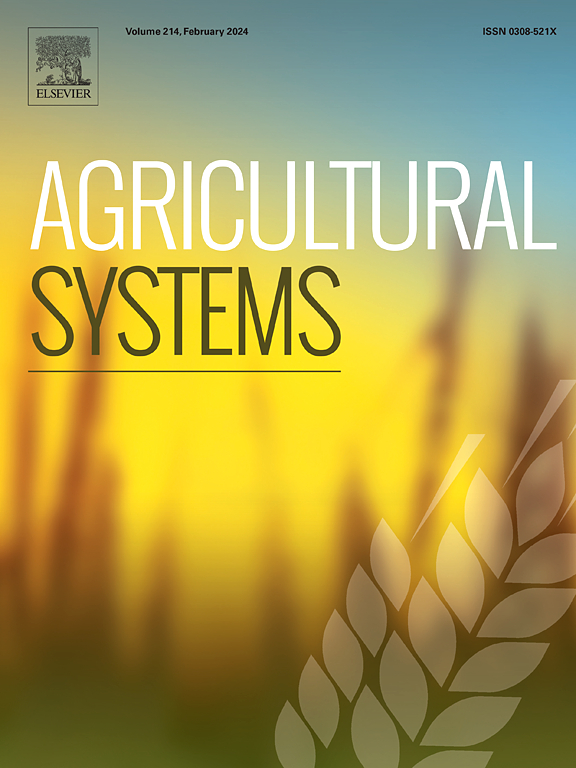空间定向保护措施的气候适应性优化,以实现经济高效的稻田管理
IF 6.1
1区 农林科学
Q1 AGRICULTURE, MULTIDISCIPLINARY
引用次数: 0
摘要
稻田对全球粮食安全至关重要,需要大量的水和管理,其效率对气候变化高度敏感。气候变化对水稻系统的水资源供应和保护措施的有效性提出了挑战。目的弥补气候变化对水稻水文和管理效率影响的研究空白。目标是评估气候预测下农业保护措施(ACPs)的成本效益,优化减少氮负荷、最大化环境效益和保持经济可行性的措施。方法将APEX-Paddy模型与SWAT模型相结合,建立SWAPX模型,模拟稻田水文和流域排水。利用四种全球气候模型(GCMs)预测未来气候条件,并通过序列算法确定了具有成本效益的保护策略,以减少氮和资源的使用。结果与结论结果表明,在特定的子流域进行有针对性的保护措施可以降低成本,降低氮负荷,并保持水稻产量。这些做法的有效性在不同的气候情景下有所不同,这突出了适应性管理战略的必要性。优化高影响子流域的保护工作可以确保成本效益和可持续的做法。意义本研究为缓解气候变化对稻田水文水质的影响提供了适应性管理策略。这些发现为决策者和农民设计具有成本效益、具有气候适应能力的农业系统提供了实际指导,从而维持生产力并减少对环境的影响。本文章由计算机程序翻译,如有差异,请以英文原文为准。

Climate-resilient optimization of spatially targeted conservation practices for cost-effective rice paddy management
CONTEXT
Rice paddies are crucial for global food security, requiring significant water and management, and their efficiency is highly sensitive to climate variability. Climate change poses challenges to water availability and the effectiveness of conservation practices in rice systems.
OBJECTIVE
This study seeks to address the existing research gap in understanding the impacts of climate change on rice paddy hydrology and management efficiency. The goal is to evaluate the cost-effectiveness of Agricultural Conservation Practices (ACPs) under climate projections, optimizing practices that reduce nitrogen loads, maximize environmental benefits, and remain economically viable.
METHODS
The study developed the SWAPX model by integrating the APEX-Paddy and SWAT models to simulate rice paddy hydrology and watershed drainage. Four Global Climate Models (GCMs) were used to project future climate conditions, and a sequential algorithm identified cost-effective conservation strategies to reduce nitrogen and resource use.
RESULTS AND CONCLUSTIONS
Results revealed that targeting conservation practices in specific subbasins reduced costs, lowered nitrogen loads, and conserved rice productivity. The effectiveness of these practices varied under different climate scenarios, highlighting the need for adaptive management strategies. Optimizing conservation efforts in high-impact subbasins can ensure cost-effective, sustainable practices.
SIGNIFICANCE
This research offers insights into adaptive management strategies for mitigating climate change impacts on rice paddy hydrology and water quality. The findings provide practical guidance for policymakers and farmers to design cost-effective, climate-resilient agricultural systems that sustain productivity and reduce environmental impacts.
求助全文
通过发布文献求助,成功后即可免费获取论文全文。
去求助
来源期刊

Agricultural Systems
农林科学-农业综合
CiteScore
13.30
自引率
7.60%
发文量
174
审稿时长
30 days
期刊介绍:
Agricultural Systems is an international journal that deals with interactions - among the components of agricultural systems, among hierarchical levels of agricultural systems, between agricultural and other land use systems, and between agricultural systems and their natural, social and economic environments.
The scope includes the development and application of systems analysis methodologies in the following areas:
Systems approaches in the sustainable intensification of agriculture; pathways for sustainable intensification; crop-livestock integration; farm-level resource allocation; quantification of benefits and trade-offs at farm to landscape levels; integrative, participatory and dynamic modelling approaches for qualitative and quantitative assessments of agricultural systems and decision making;
The interactions between agricultural and non-agricultural landscapes; the multiple services of agricultural systems; food security and the environment;
Global change and adaptation science; transformational adaptations as driven by changes in climate, policy, values and attitudes influencing the design of farming systems;
Development and application of farming systems design tools and methods for impact, scenario and case study analysis; managing the complexities of dynamic agricultural systems; innovation systems and multi stakeholder arrangements that support or promote change and (or) inform policy decisions.
 求助内容:
求助内容: 应助结果提醒方式:
应助结果提醒方式:


